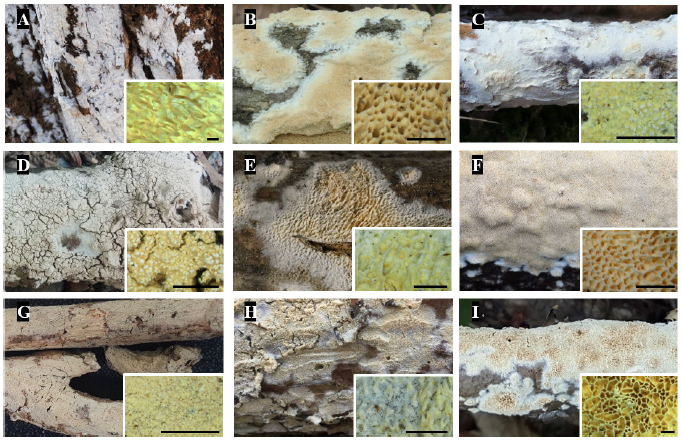Research Note
Abstract
Following the taxonomic reassignment of Schizopora and some Hyphodontia species into Xylodon, we confirmed nine Korean species of Xylodon in a previous study. In the present study, we propose Korean names for these Xylodon species according to the Principles of the Mycological Terminology Review Committee of The Korean Society of Mycology.
Keyword
Xylodon (Pers.) Fr., typed Xylodon quercinus (Pers.) Gray (1821), is a genus of wood-decay fungus belonging to the family Schizoporaceae Jülich of the order Hymenochaetales. Xylodon species are found worldwide and cause white rot in angiosperms and gymnosperms [1,2]. They are characterized by resupinate basidiomes, numerous types of hymenophores and cystidia, basidia with four sterigmata, and globose to ellipsoid basidiospores [3]. Owing to mutual morphological characteristics shared with other resupinate fungi, several Xylodon species have been placed in other genera, such as Hyphodontia [4]. Based on morphological and molecular data, several species from genera, such as Lagarobasidium and Schizopora, have been transferred to Xylodon, which, as the oldest genus in the family, had priority over others [5,6].
In a previous study, we proposed a taxonomic revision of Xylodon in Korea based on genetic and morphological data, resulting in nine species [7]: X. asperus, X. flaviporus, X. kunmingensis, X. nespori, X. niemelaei, X. ovisporus, X. serpentiformis, X. spathulatus, and X. subflaviporus. Species formerly placed in Hyphodontia and Schizopora were reclassified. Xylodon paradoxus (≡ Schizopora paradoxa), which, based on morphology, had previously been frequently reported in Korea, was revealed to be absent in the country [7]. In addition, we included a revision of the internal transcribed spacer (ITS) and nuclear large subunit ribosomal RNA (nrLSU) GenBank sequences corresponding to the nine Xylodon species in Korea, highlighting the importance of validating the sequences before using them as a reference.
The Republic of Korea is among the few nations to conduct research on Xylodon for possible applications in biotechnology or medicine. Xylodon flaviporus, the most common species in Korea, has been investigated in some studies, which have revealed its potential for bioremediation [8] and inhibition of osteoclastogenesis [9]. Here, we propose Korean names for each Xylodon species present in Korea (Table 1) according to the Principles of the Mycological Terminology Review Committee of The Korean Society of Mycology (2012). The basidiomes of the nine species are presented in Fig. 1 for an easier understanding of their etymologies. The proposal of new Korean names and revisions of previous names reflect the current taxonomic status of Xylodon. The Korean names will facilitate easier identification of Xylodon species and improve further research on these species in Korea.
Xylodon (Pers.) Gray emend Riebesehl & E. Langer Mycological Progress 16(6):637 (2017)
Type species: Xylodon quercinus (Pers) Gray (1821)
Synonyms: ≡ Schizopora Velen., Ceske Houby 4-5: 638 (1922)
≡ Lagarobasidium Jülich, Persoonia 8 (1): 84 (1974)
≡ Odontiopsis Hjortstam & Ryvarden, Mycotaxon 12 (1): 180 (1980)
≡ Palifer Stalpers & P.K. Buchanan, New Zealand Journal of Botany 29: 339 (1991)
Korean name: 좀구멍버섯속 Etymology (Korean): Preservation of the name for Schizopora (좀구멍버섯).




